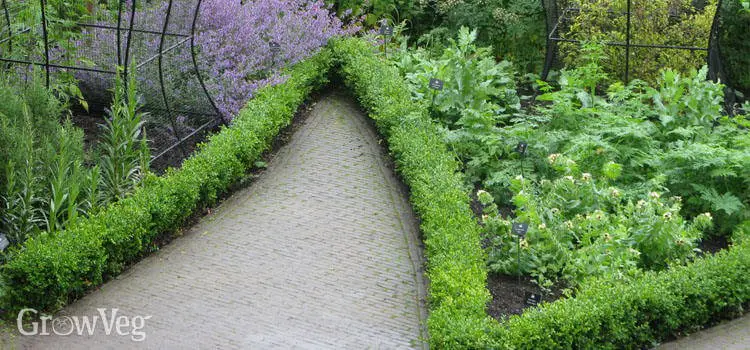Standard Garage Size: Dimensions For 1, 2, 3 & 4 Cars (Photos)
Cars are a fundamental aspect of modern life, providing a sense of convenience and freedom. However, housing them in a garage can be a challenge, especially when space is limited. It’s essential to consider the right size of garage for your home, taking into account not only the cars themselves but also the potential for creative usage of the space.
A larger garage can offer a wealth of possibilities, from providing a flexible space for hobbies or entertainment to serving as an extension of your living area. In fact, many homeowners design their garages with this versatility in mind, recognizing the value of having a large, open space that can be used in various ways. This post will provide you with a comprehensive overview of standard garage sizes, including dimensions for one-car, one-and-a-half car, two-car, and three-car garages.
Additionally, we’ll touch on average residential garage height, depth, and the space required between cars. Whether you’re looking to build or renovate your garage, it’s crucial to consider the unique needs of your home and family. From compact cars to luxury SUVs, we’ll explore the average dimensions for various vehicle types, helping you plan and design a garage that meets your specific requirements.
Standard garage dimensions
Despite the prevalence of varied standards, the definition of a standard garage size remains shrouded in uncertainty. Many homeowners and car enthusiasts alike struggle to pinpoint an exact dimension. A more practical approach, however, might be to consider the number of vehicles to be accommodated. For instance, a two-car garage would provide ample space for most users.
From a technical standpoint, the average standard garage dimension is often estimated at 9-10 feet in width per car and 20-24 feet in depth.
1-car garage dimensions
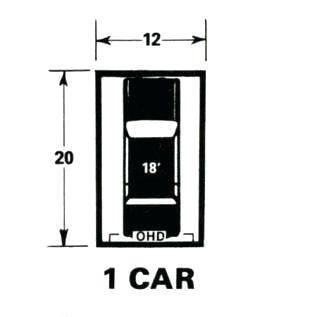
In many townhouses, condos, and small residential homes, one-car garages are a staple due to their practicality. For homeowners who prefer not to park multiple vehicles or prioritize limited parking options, these compact spaces can be an ideal solution. When designing a one-car garage, it’s essential to consider the dimensions carefully.
Typically, this type of garage features a doorway with a width of approximately 9 feet, an interior space that measures around 12 feet deep, and a total depth of about 20 feet. With these proportions, the area can comfortably accommodate a clearance of roughly 2.8 feet, allowing for a small section dedicated to extracurricular activities or storage needs.
5 car garage dimensions
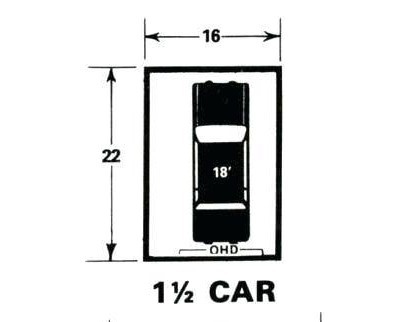
When it comes to home renovations, some homeowners opt for a wider spaced garage area to accommodate an additional half of a parking space. This is particularly appealing to car owners who want to maximize their garage’s potential. A 1.5-car garage, by definition, falls between the dimensions of a single-car and double-car garage. Specifically, this type of garage typically features a doorway width ranging from 16-20 feet, with a minimum depth of at least 20 feet. Having a 1.
5-car garage can be incredibly beneficial for homeowners who have one vehicle but want to utilize the extra space for storage or provide a more spacious area for moving around when working on projects in the garage.
2-car garage dimensions
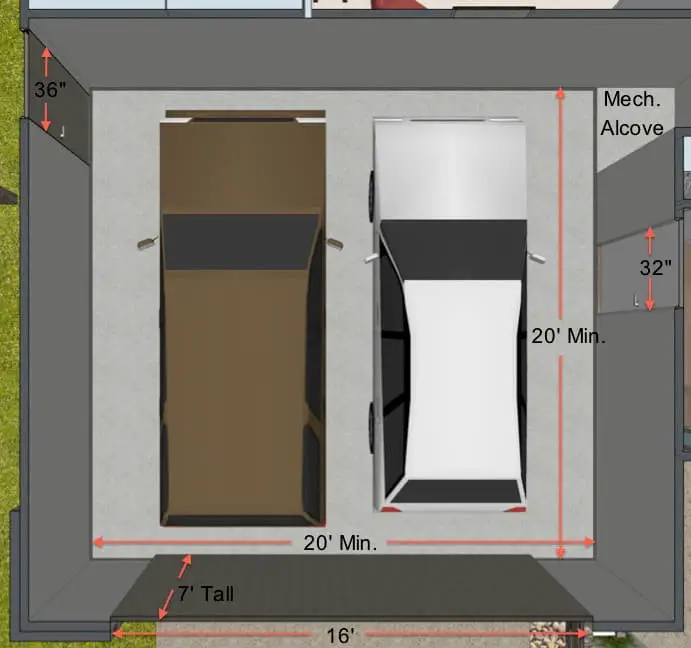
The humble two-car garage remains a perennial favourite among homeowners. Its practicality and adaptability make it an ideal choice for small homes as well as larger households. The term ‘two-car garage’ speaks for itself, intended to accommodate two vehicles simultaneously. When it comes to the dimensions of such a space, there are specific guidelines to ensure comfortable usage. A doorway with a width of at least 16 feet is crucial, allowing for ample clearance and easy entry/exit.
Additionally, an interior width of around 18 feet and a depth of approximately 20 feet provide sufficient room for individuals to move about freely while also permitting the doors to open unhindered.
2 1/2 car garage dimensions
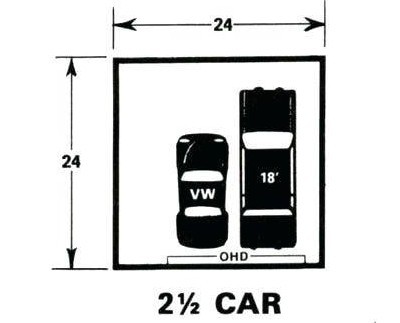
For those seeking ample space to work on their vehicles or store equipment, a 2 and ½ garage dimension offers the perfect solution. This size provides enough room to install storage and hanging cabinets, creating a functional workstation for free days. Moreover, a wider garage allows cars to have more breathing room and presents a more aesthetically pleasing appearance. A 2 and 1/2 garage car garage dimensions, ideal for car owners, falls between the parameters of a two-car and three-car garage.
Specifically, this means a doorway width ranging from 24-30 ft and a depth not less than 40-50 ft. This increased space requirement also applies to the home itself, making it essential to consider when designing or renovating.
3-car garage dimensions
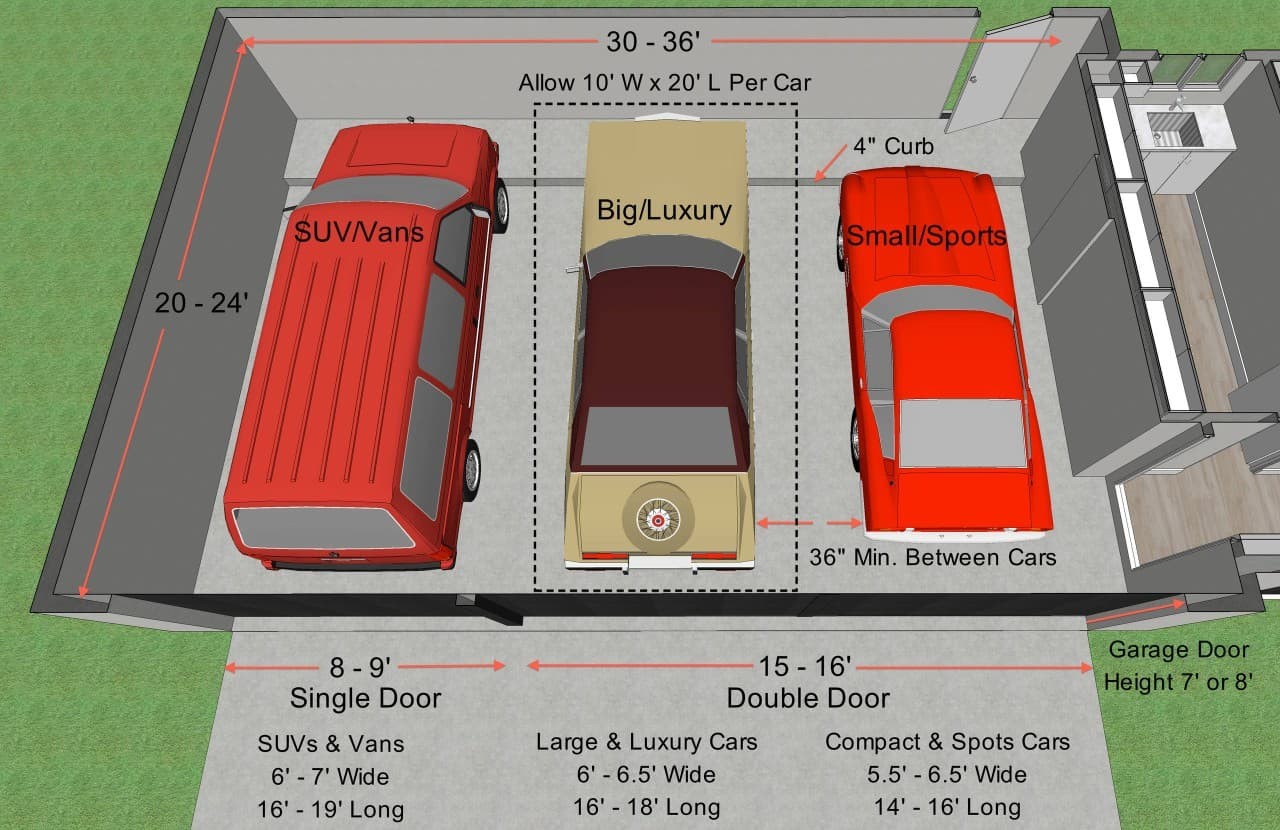
When planning a garage for a growing family, a three-car dimension is often sufficient to accommodate storage needs and provide ample workspace. However, careful consideration must be given to ensure optimal functionality. A good starting point is determining the doorway size: for double doors, aim for 16-ft in width, while single doors can safely occupy an 8-ft width.
Looking inward, a minimum interior width of 28-ft and depth of at least 20-ft (and potentially more) will provide ample space for storing items and working on projects.
3 1/2 car garage dimensions
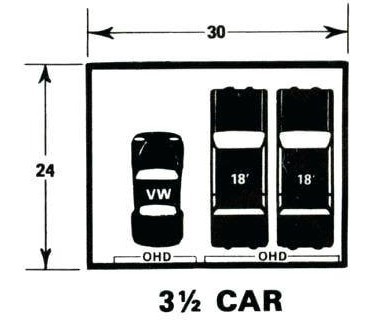
4-car garage dimensions
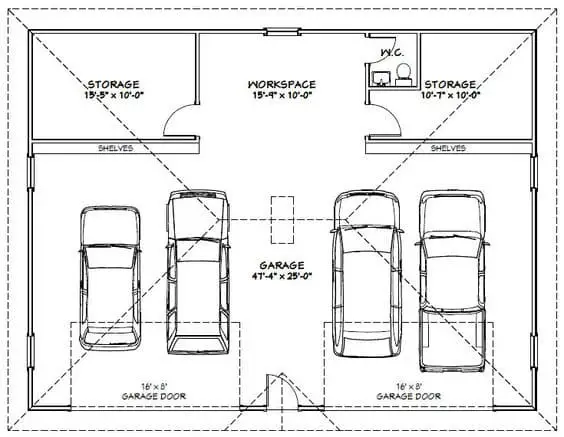
Imagining a garage that can accommodate four cars is the epitome of luxury living. This spacious haven not only provides ample room for your vehicles but also includes dedicated areas for various car maintenance tasks. To fully appreciate its grandeur, consider the following specifications: a 16-foot wide doorway on each double door, an interior width of 36 feet, and a depth of 22 feet.
These dimensions allow for seamless storage and organization, making it possible to comfortably house not only four cars but also smaller vehicles like bicycles. With this generous space, you can conveniently store multiple cars of varying sizes, each tailored to meet specific needs. However, before making a purchase, ensure that you have a substantial area available to accommodate these vehicles, allowing them to rest comfortably within their new home.
Average Residential Garage Height
Garage enthusiasts often overlook the importance of optimal clearance when selecting their garage dimensions. While an average height of around 9 feet is common and sufficient for most standard vehicles to fit comfortably, some homeowners advocate for a slightly taller structure of approximately 10 feet. This increased height allows for the installation of additional support beams, which can be crucial in maintaining the structural integrity of the garage.
Ultimately, it’s essential to prioritize ample headroom within your garage, as this will ensure a more comfortable and functional space for parking and storing vehicles.
Standard Garage Depth
Typically, standard garage dimensions span a range of approximately 20 to 24 feet in depth, providing ample space for installing cabinets and storage units measuring around 1-1.5 feet in size. Beyond accommodating these essential features, this garage depth also allows for comfortable movement and various activities, ensuring a practical and functional space for car enthusiasts and homeowners alike.
Space between cars
While a typical car clearance should be around 76cm from any obstruction to ensure a safe and comfortable driving experience, it’s not uncommon for individuals with limited living spaces to require a more condensed setup. In such cases, it may be necessary to adjust the space accordingly and exercise heightened caution when opening doors to compensate.
Average Vehicle Dimensions
When considering standard garage sizes, it’s crucial to understand that they directly depend on the type of vehicle being accommodated. To effectively plan and optimize your garage space, having a solid grasp on average vehicle dimensions is essential. This knowledge will enable you to determine how much space to allocate for the vehicle, as well as which dimensions may need adjustment to ensure a proper fit.
Compact cars
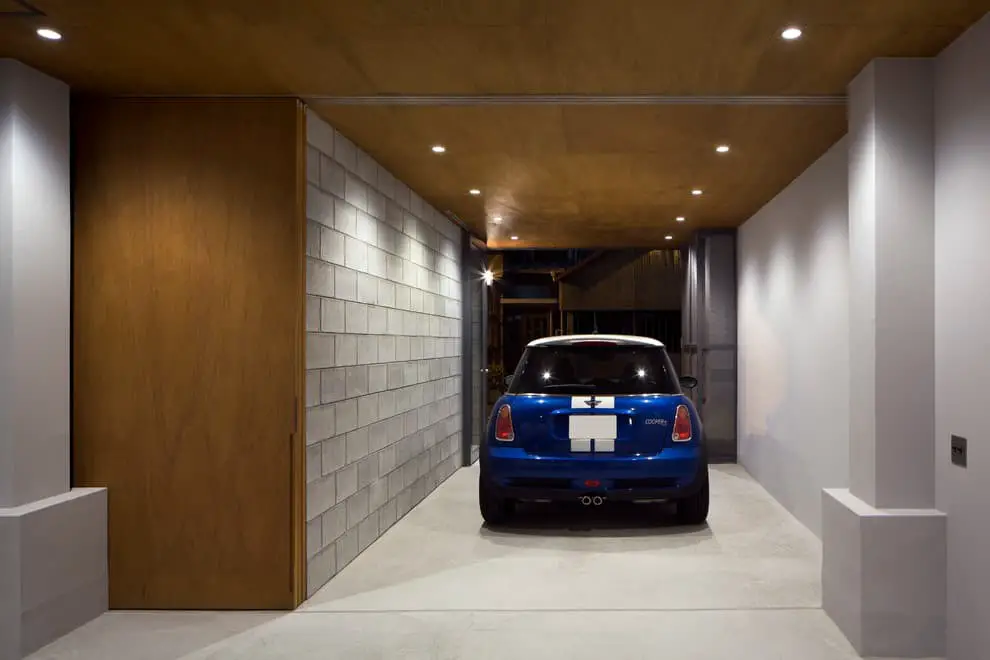
Medium-sized cars, also referred to as compact cars, are often the preferred choice for individuals or small families with a typical household size ranging from two to four members. In terms of physical dimensions, these vehicles typically measure between 4109mm and 4370mm in length, stand at a height of approximately 1424-1530mm, and have a width that falls within the range of 1729-1823mm.
Sport cars
These luxury vehicles are characterized by their impressive engine performance, often attracting high-profile individuals such as executives and business moguls. A notable feature is the two-seater design, optimized for precise control at elevated speeds. The car’s dimensions typically range from 3995 to 5027 mm in length, 1116 to 1475 mm in height, and 1735 to 1992 mm in width.
Mid-sized cars
Intermediate cars occupy a unique space in the automotive market, offering a sizeable upgrade from compact vehicles while still being smaller than full-size cars. This sweet spot makes them an attractive option for families, as they can comfortably seat four to six people depending on the specific make and model.
In terms of dimensions, intermediate cars typically measure between 4425-4726 mm in length, 1418-1575 mm in height, and 1810-1910 mm in width, providing ample space without overwhelming urban environments.
Full-sized cars
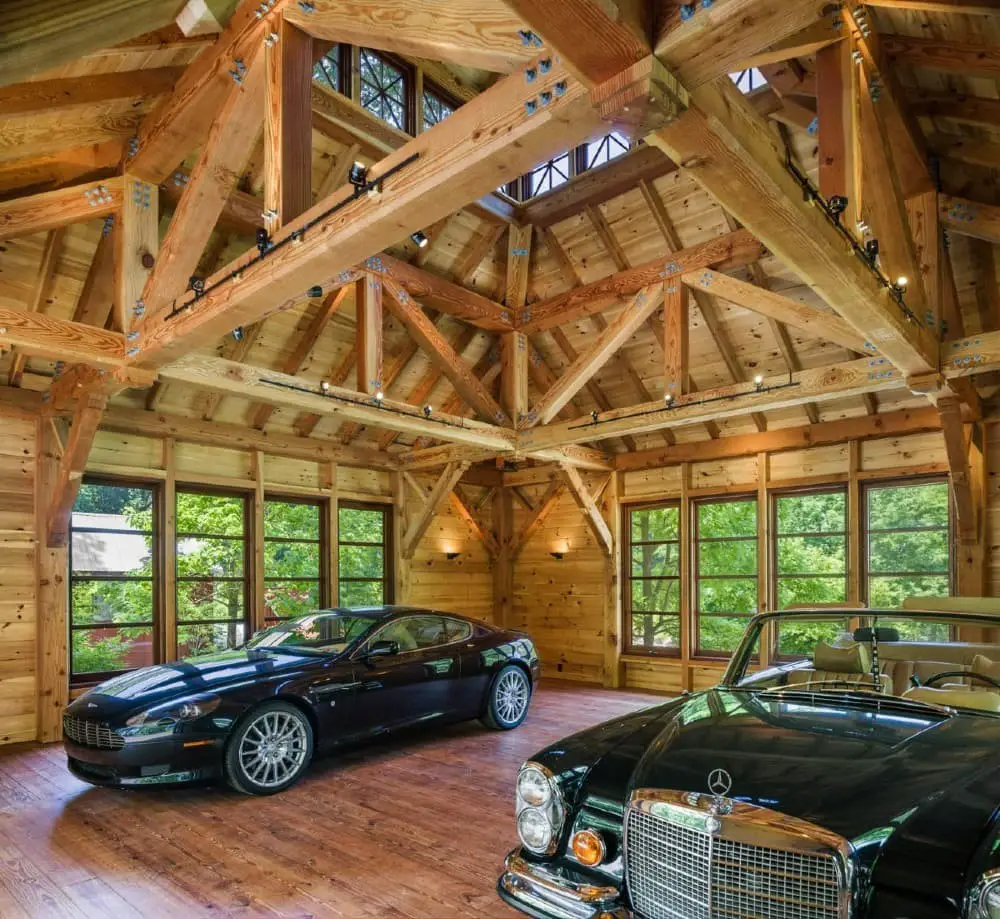
This behemoth of a vehicle is designed to accommodate multiple passengers or serve as a cargo carrier. Its impressive size sets it apart from mid-sized cars, offering ample space for comfort. Measuring approximately 5,000 mm in length, 5,350 mm in height, and 2,790 mm in width, this car’s dimensions are truly noteworthy.
Pick-ups
Pickups are designed to offer ample interior space, making them an ideal choice for those embarking on journeys with limited luggage. Their versatility allows for easy transportation of essential items, which can be stowed away in the rear compartment. In terms of measurements, pickups typically boast dimensions ranging from 5205-5632 mm in length, 1775-1815 mm in height, and 1760-2008 mm in width.
Luxury Cars

While regular cars may offer sufficient comfort and features for daily driving, luxury vehicles aim to exceed expectations with premium amenities, top-notch performance, and refined design. These high-end models typically boast larger dimensions than their more affordable counterparts, measuring between 4631-5624mm in length, 1294-1496 mm in height, and 1877-1980 mm in width.
Small Crossovers
This compact crossover effortlessly blends style, technology, fuel efficiency, and practicality, making it an ideal choice for daily driving. While its primary purpose is to navigate paved roads, it also boasts off-road capabilities. With dimensions that vary slightly depending on the model, this car typically measures between 3700-4300 mm in length, 1529-1679 mm in height, and 1660-1822 mm in width.
Compact SUVs
The compact SUV’s unique selling point lies in its elevated seating position, offering drivers a commanding view of the road while providing comfort and support within the cabin. Its design also makes it an excellent fit for anyone seeking a versatile vehicle.
A key characteristic of this type of car is its high driving position and rugged aesthetic, evoking the spirit of off-road adventure without the need for four-wheel drive capabilities.
As such, it’s primarily designed for on-road use, where its dimensions become particularly noteworthy. With a length ranging from 4255 to 4730 mm, height varying between 1494 and 1740 mm, and width spanning 1790 to 1925 mm, the compact SUV is an attractive option for those seeking a practical and spacious ride.
Full-sized SUVs
Full-sized SUVs boast impressive capabilities, making them well-suited for handling various hauling tasks. Whether it’s towing boats, horse trailers, work trailers, or even other trucks, these vehicles are up to the task. Their robust nature also enables them to serve as reliable cargo carriers, effortlessly managing large and heavy loads. When embarking on a trip that requires a bit of everything – space, power, and versatility – full-sized SUVs prove to be an excellent choice.
Measuring between 4662-5130mm in length, 1623-2035 mm in height, and 1760-2008mm in width, these vehicles offer ample room for both people and cargo.
FAQs
In addition to understanding the typical garage dimensions, it’s crucial to gain insight into other vital factors that impact its functionality. For instance, knowing how to effectively arrange a garage and incorporating practical items can significantly enhance its usability. To provide a comprehensive perspective, let me address some frequently asked questions about garages that every homeowner should be aware of.
What can a garage be used for?
Maximizing space in your garage is not limited to its traditional purpose. When cars are temporarily absent, the area can be repurposed to accommodate various needs. A workshop area can be created by dedicating spaces for tool storage and material organization. This DIY approach allows you to customize the layout according to your work requirements. Alternatively, your garage can be transformed into a bedroom or mobile sleeping space when you desire an outdoor adventure.
The large expanse of the garage provides ample room for creative expression through decorations and other design elements. Furthermore, the garage’s spaciousness lends itself well to conversion into a kitchen area. With the ability to accommodate various cooking appliances, such as electric, gas, or butane stoves, your garage can become a comfortable dining space for friends and family.
As with any repurposing project, maintaining a clean and organized environment is crucial to ensure a seamless transition between uses.
Factors to consider when planning a car garage
When designing a car garage, it’s crucial to consider several key factors before getting started. A primary consideration is the type of vehicle you plan to store in the garage. For instance, compact cars don’t require as much space as larger vehicles like SUVs or family cars. Another factor to weigh is how you intend to use your garage. Will you need additional storage space or a workshop area? If so, a larger garage size may be necessary, even if you only have one vehicle.
It’s also essential to familiarize yourself with local regulations and zoning codes, as these can vary significantly depending on where you live. For example, there may be specific guidelines for door hardware, alarm systems, or overall garage size. By taking the time to understand these factors upfront, you’ll be better equipped to plan a garage that meets your needs and complies with local requirements.
What is the cheapest car garage to build?
When it comes to building a garage on a budget, one cost-effective option is the pole-style garage design. Characterized by their resemblance to traditional stick-built structures, these affordable garages utilize innovative materials such as reinforced wood or coated steel, offering a unique blend of affordability and durability.
Does a garage add resale value to a home?
A definitive affirmative can be given when considering the return on investment for adding a garage. Real estate reports indicate that such an upgrade can yield a significant payoff, with a guaranteed return of more than 80%. To put this into concrete terms, it’s estimated that a garage can add approximately $21,000 to a home’s resale value, making it a worthwhile investment for homeowners looking to increase their property’s value.
Conclusion
While garages are often defined by the cars they house, they also play a crucial role in extending home spaces for various activities. Whether it’s a compact one-car garage or a spacious four-car garage, maximizing its potential is endless. As newer and bigger car designs emerge, personal style and specific needs should remain top priorities when designing or arranging the space. Ultimately, understanding standard garage sizes is key to creating an effective layout.
Related Posts
When it comes to selecting a garage door color that complements your yellow house, finding the perfect combination can be a challenge. To achieve curb appeal, you’ll want to consider the natural hue of your home and choose a garage door shade that harmonizes with it. A popular option is to match the color of your roof, as this creates a cohesive look. For instance, if your roof is a warm beige or golden brown, a matching garage door can tie the two together seamlessly.
Alternatively, you can opt for a bold contrasting color to create visual interest and add some excitement to your home’s exterior. Consider a deep blue or rich green to create a striking combination that adds depth and dimension. Ultimately, when choosing a garage door color to pair with your yellow house, remember to balance boldness with harmony to achieve a look that’s both eye-catching and aesthetically pleasing.




